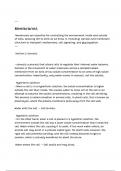---
Membranes
Membranes are essential for controlling the environment inside and outside
of cells, allowing life to exist as we know it. Including: osmosis and membrane
structure to transport mechanisms, cell signaling, and glycosylation.
---
Section 1: Osmosis
- osmosis: a process that allows cells to regulate their internal water balance.
Osmosis is the movement of water molecules across a semipermeable
membrane from an area of low solute concentration to an area of high solute
concentration. Importantly, only water moves in osmosis, not the solutes.
Hypertonic solution:
- When a cell is in a hypertonic solution, the solute concentration is higher
outside the cell than inside. This causes water to move out of the cell in an
attempt to balance the solute concentrations, resulting in the cell shrinking.
This process is called crenation in animal cells. In plant cells, this is known as
plasmolysis, where the plasma membrane pulls away from the cell wall.
Water exits the cell → Cell shrinks.
Hypotonic solution:
- On the other hand, when a cell is placed in a hypotonic solution, the
environment outside the cell has a lower solute concentration than inside the
cell. Water enters the cell, causing it to swell. If too much water enters, an
animal cell may burst in a process called lysis. For plant cells, however, the
rigid cell wall prevents bursting, and the cell instead becomes turgid or
swollen, which is actually beneficial for plant structure.
Water enters the cell → Cell swells and may burst.
,Isotonic solution:
- Finally, in an isotonic solution, the concentration of solutes is the same
inside and outside the cell. There is no net movement of water in or out, so the
cell remains stable. This is the ideal condition for animal cells, such as your
red blood cells, which must maintain an isotonic environment to function
properly.
No net water movement → Cell remains the same size.
- osmosis is crucial for maintaining cell volume, especially in environments
with varying solute concentrations.
---
Section 2: Membrane Structure
- The structure of the cell membrane, often described as a fluid mosaic model.
The primary component of the membrane is the phospholipid bilayer. Each
phospholipid has a hydrophilic (water-loving) head made of a phosphate group
and a hydrophobic (water-fearing) tail made of fatty acids. This dual nature is
critical for membrane function."
- In water, phospholipids arrange themselves into two layers, with the
hydrophilic heads facing outward toward the water on both sides, and the
hydrophobic tails tucked inside. This organization makes the membrane
selectively permeable—allowing some molecules to pass through, while
keeping others out. This property is vital for maintaining the distinct internal
environment of the cell.
, - Membrane fluidity is crucial for various cell functions, such as allowing
proteins to move and enabling the membrane to repair itself. This fluidity is
regulated by cholesterol, which is found between the phospholipids. At high
temperatures, cholesterol keeps the membrane from becoming too fluid, and
at low temperatures, it prevents it from becoming too rigid.
- Next, we have proteins, which perform many of the membrane’s essential
functions. Integral proteins span the entire membrane and are involved in
transport, acting as channels or carriers to move substances across the
membrane. Peripheral proteins are located on one side of the membrane and
are involved in signaling or providing structural support.
- Membrane proteins are incredibly diverse. For example, transport proteins
help substances that cannot pass through the lipid bilayer to cross the
membrane, while receptor proteins detect external signals, allowing the cell
to respond to changes in its environment. The membrane truly acts as the
cell's control center, managing interactions with the outside world.
---
Section 3: Transport Mechanisms
- The membrane uses both passive transport and active transport to control
what enters and exits the cell.
- In passive transport, molecules move from an area of high concentration to
an area of low concentration, without the need for energy. The simplest form
of passive transport is simple diffusion, where small, non-polar molecules like
oxygen (O2) and carbon dioxide (CO2) pass directly through the lipid bilayer.




